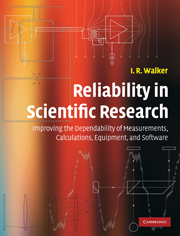 Reliability in Scientific Research
Reliability in Scientific Research Book contents
- Frontmatter
- Contents
- Preface
- List of abbreviations
- 1 Basic principles of reliability, human error, and other general issues
- 2 Mathematical calculations
- 3 Basic issues concerning hardware systems
- 4 Obtaining items from commercial sources
- 5 General points regarding the design and construction of apparatus
- 6 Vacuum-system leaks and related problems
- 7 Vacuum pumps and gauges, and other vacuum-system concerns
- 8 Mechanical devices and systems
- 9 Cryogenic systems
- 10 Visible and near-visible optics
- 11 Electronic systems
- 12 Interconnecting, wiring, and cabling for electronics
- 13 Computer hardware and software, and stored information
- 14 Experimental method
- Index
- References
8 - Mechanical devices and systems
Published online by Cambridge University Press: 05 June 2012
- Frontmatter
- Contents
- Preface
- List of abbreviations
- 1 Basic principles of reliability, human error, and other general issues
- 2 Mathematical calculations
- 3 Basic issues concerning hardware systems
- 4 Obtaining items from commercial sources
- 5 General points regarding the design and construction of apparatus
- 6 Vacuum-system leaks and related problems
- 7 Vacuum pumps and gauges, and other vacuum-system concerns
- 8 Mechanical devices and systems
- 9 Cryogenic systems
- 10 Visible and near-visible optics
- 11 Electronic systems
- 12 Interconnecting, wiring, and cabling for electronics
- 13 Computer hardware and software, and stored information
- 14 Experimental method
- Index
- References
Summary
Introduction
Mechanisms in general are a notorious source of reliability problems. This chapter deals with mechanical devices and systems (broadly construed) that are of particular concern in experimental work. The former include precision mechanisms, static and dynamic vacuum seals, and valves. A brief discussion of devices for preventing mechanical overtravel and overload is also included.
Mechanical devices that are used under extreme conditions (e.g. in ultrahigh-vacuum and cryogenic environments) often suffer from friction and wear problems due to a lack of lubrication. A section of the chapter is devoted to lubricants (and especially dry lubricants and self-lubricating solids) that are useful under such conditions.
Water-cooling systems are a common source of trouble in apparatus ranging from small-scale tabletop equipment (e.g. lasers) to large particle accelerators. Such problems include leaks, cooling-line blockages, corrosion, and condensation. These issues, and others, are discussed below.
Mechanical vacuum pumps are dealt with in Chapter 7, while electrical connectors and cables (which are partly mechanical devices) are discussed in Chapter 12.
Mechanical devices
Overview of conditions that reduce reliability
Some agents and environmental conditions that tend to diminish the reliability of mechanical parts and systems are as follows.
(a) Particulate matter such as dust and grit can be very harmful to mechanical devices. It leads to accelerated wear and damage of moving parts (especially antifriction bearings, such as ball bearings), leaks in sealing devices, a decrease in the accuracy of precision mechanisms, and instabilities in mechanical assemblies requiring accurate registration of surfaces.
(b) Moisture (including high humidity) causes corrosion and promotes biological growth (i.e. mold and fungi, which can release corrosive chemicals), degrades lubricants, and holds particulate matter that would otherwise escape on surfaces. […]
- Type
- Chapter
- Information
- Reliability in Scientific ResearchImproving the Dependability of Measurements, Calculations, Equipment, and Software, pp. 218 - 284Publisher: Cambridge University PressPrint publication year: 2011


